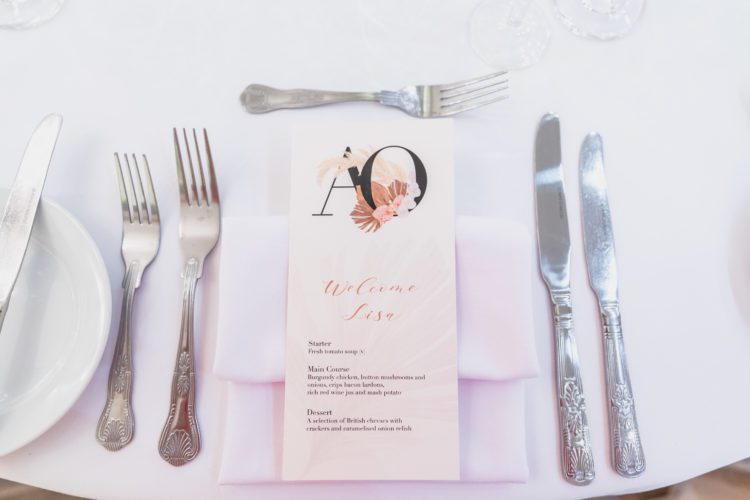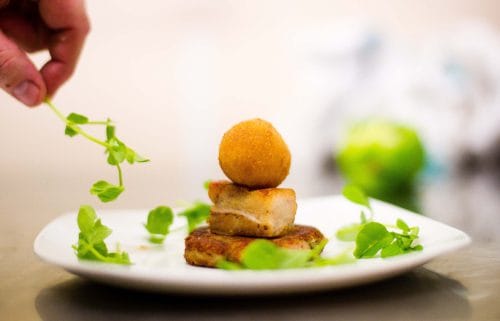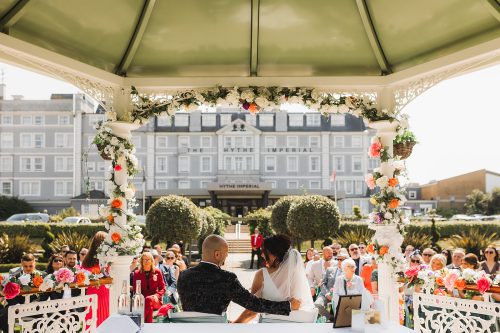Our guide to planning fantastic wedding stationery
For many couples, selecting the wedding stationery will be one of the most exciting times of their engagement (after selecting your Kent wedding venue of course!). It could very well be the first inkling guests get of your wedding theme – but before you order your wedding stationery it’s a good idea to put together a list of all the things you’ll need to print, email or simply consider.
To help you with your wedding stationery planning, we have compiled the Hythe Imperial Hotel’s guide to the various stationery items you might choose to include before, on and after your big day. Keep in mind, though, some of these elements are optional, and you could even consider making them yourselves if you are the creative types (which will enable you to make them really personalised) or you could decide to send the whole lot electronically to save money – and the planet!
BEFORE THE WEDDING
Engagement party invitations
If you’re having a formal engagement party, then it is probably best to send invitations two to three months in advance; if your celebration is a more casual one, then four to six weeks should allow plenty of time. They should include the venue, date, time, and any required dress code.
Save the date cards
While not compulsory, these are a useful announcement of your wedding date and location and let your guests get the date in their diaries knowing that they will be invited to celebrate your special day with you. These should be sent at least six months to a year in advance – even earlier if you are planning a destination wedding so that your guests can consider aspects such as flights, accommodation and childcare.
Bridal shower invitations
Bridal showers are relatively new in the UK. Traditionally, the bridal party – your bridesmaids and maid of honour – host the bridal shower; therefore, they should send the invitations on your behalf. Typically, these are sent two to three months prior, and the invitation should include location, time, date, and whether there’s a theme and if any details are a surprise for the bride.
Stag/Hen party invitation
If you are planning intimate gatherings of close family and friends, it may be easier to organise everything over email or by a stag/hen WhatsApp group. If you’re thinking of hosting larger parties, or you are travelling abroad, then invitations should be sent out at least two to three months beforehand and include all details and what’s expected of the guests.
The wedding invitation
This is probably the most important invite you’ll ever send! Depending on your own style, you could opt for the very traditional approach and send a full invitation suite, which involves choosing paper, fonts, and multiple elements to inform your guests in true style. Alternatively, you could send digital invitations that lead people to a bespoke website.
If you’re going for traditional wedding stationery, you should consider:
Outer and inner envelopes
With your address book in hand, the outer envelope should include the address of your guest/guests and a stamp in the top right-hand corner. It’s always worth checking the postage is accurate! – no one wants to make a special trip to the post office for underpaid postage. You could also pop the invitation into an inner envelope which ensures guests receive a pristine envelope after it’s passed through the sorting office!
You can also have fun with complementary fabric or ribbons to hold all of the elements together.
Invitation card
The invitation card itself should be the most prominent item in the suite. This should include the host of the wedding, names of the couple getting married, date, time, and name and location of the venue for both the ceremony and reception. If your celebration takes place under one roof in a venue like the Hythe Imperial Hotel, include something like ‘wedding breakfast and dancing to follow’ and make sure to include the dress code.
Gifts
If you’re having a gift list, details of the shop or website should be included. Politely-worded requests for gifts of money or vouchers should also be included here.
Directions/Map card
Google Maps (or similar) have largely done away with directions and map cards, but they aren’t completely obsolete and can in fact be a fun (and useful!) add-on, especially if your wedding venue is tricky to find or you have older guests.
RSVPs with menu response and self-addressed stamped envelopes
RSVP cards are typically the most traditional way to collate responses, and each should include a clear deadline for replying, as well as tick boxes for ‘accepts with pleasure’ and ‘declines with regret’. Whilst traditional RSVP cards use a lot of white space, modern cards include spaces in which guests can write their names and even contain menu choices to simplify the guest RSVP process. Collecting RSVPs online is also becoming a popular option; if this method appeals to you, we still recommend sending a response card, but tell guests to RSVP online and include a link.
Did you know? RSVP is an acronym for the French ‘Répondez S’il Vous Plaît,’ which, when translated, means ‘please respond,’ so, if you decide to use ‘RSVP’ on your card, it should not be preceded by the word please.
ON THE WEDDING DAY
Ceremony programme/order of service
If you choose to provide one, an order of service should typically include the names of the couple, date, ceremony and reception venue, a welcome paragraph, an outline of the proceedings and anything else you’d like to include. Church weddings would also feature the words to the hymns to be sung.
Seating chart, table number and place cards
Seating charts, placed at the entrance of the reception, and table numbers help direct guests to their assigned tables and you can have fun with these – think of your theme and adapt! Individual place cards ensure your guests know where to sit, so are not necessary if your seating arrangement is to be completely informal. Place cards can be helpful should you choose a sit-down reception as you can include menu choices inside to remind your guests what they chose to eat!
Menus
Menus showing what is being served (meal and wine, champagne for the toast, etc.) can be a nice touch and look great on all the tables when they complement the place cards.
AFTER THE WEDDING
Thank you cards
Generally, thank you cards should be handwritten (for that added touch) and include the name of the gift giver, what is was they gave, and a personal message. They should be sent as soon as possible after your wedding and honeymoon. You can personalise thank you cards by including a photo from your magical day on the front or with a photo within.
We hope our guidance has given you lots of wedding stationery ideas! Now all that’s left for you and your fiancé to do is share your upcoming nuptials with your nearest and dearest!
Send us an email today to discuss your wonderful wedding ideas here at Hythe Imperial Hotel.




